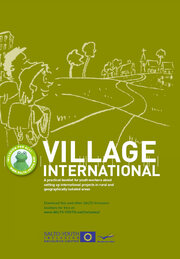Rural & geographically disadvantaged youth
Many people have come up with definitions for the term 'rural', but seldom do these rural definitions agree with each other. For some, 'rural' is a subjective state of mind. For others, 'rural' is an objective quantitative measure.
- What do we mean by 'rural' and 'geographically isolated' areas?
- Where does it start? And where does it end?
- How peripheral does an area have to be in order to be called ' rural'?
- How many people live in 'rural' and 'isolated' areas?
The Organisation for Economic Cooperation and Development (OECD) sets quantitative criteria for 'rural' and states that:
- "If 50% of the population of a region live in rural communities, the region is defined as a rural area. Communities with a population of less than 100 inhabitants per km2 are defined as rural communities".
In some of the latest European Commission articles on rural development and policies (2007-13) in Europe, they say that:
- "Rural areas represent more than 90% of EU territory and contain more than half of the EU's population."
The European Commission states that rural areas are diverse and include many important regions. However, some rural areas, and in particular those which are the most remote, depopulated or dependent on agriculture, face particular challenges as regards growth, jobs and sustainability in the coming years. These include:
- lower levels of income,
- an unfavourable demographic situation,
- lower employment rates and higher unemployment rates,
- a slower development of the tertiary sector,
- weaknesses in skills and human capital,
- a lack of opportunities for women and young people,
- a lack of necessary skills in parts of the agricultural sector and food processing industry
Get Active - Exercise - What is your definition of 'rural'?
Try to write down what you would consider 'rural youth' to be - and what it is not? Where do you put the boundary? Is it important to distinguish between 'rural' and 'non-rural' youth? Why?
- This could be a good exercise to do with the people in your (rural) youth organisation and with your partners when doing an international project, to see if you are talking about the same concepts.
^^ top ^^
Different degrees of 'rural' and 'isolated'
When having a conversation, 'rural' is not always the equivalent of 'rural', as sometimes people have a completely different geographical setting in mind when using the word.
- For example, there are 'rural areas' located at the fringes of urban areas that are expanding and these villages benefit from employment as well as leisure time activities and have an excellent infrastructure linking into the city. These areas are doing very well and are extremely popular places to live, because of the quality of life. They can take advantage of their vicinity to the city (e.g. access to jobs, education, cultural life, good public transport, etc.) and enjoy the benefits of living in the countryside at the same time.
The focus of Village International is more on young people living in rural areas which are less developed and more remote, those we refer to when talking about 'geographically isolated' or 'geographically disadvantaged' areas. This can be mountain villages, distant valleys, small islands or simply a small town or village far away from the bigger cities.
Young people in these rural and isolated areas often face a series of challenges:
- fewer opportunities for formal and non-formal education: specialised schools and universities as well as youth NGOs are often non-existent,
- employment: there is a small jobs market and high unemployment rate among youngsters,
- leisure time activities: few or no cultural activities such as theatre, cinema, concerts,
- transport and mobility: public transport is often non-existent or very scarce,
- lack of information about youth-related issues, opportunities and initiatives,
- healthcare: the nearest hospital and specialised doctors are far away,
- frequent alcohol and smoking problems among youngsters due to boredom and lack of opportunities: the local bar is often the only meeting point in the village,
- infrastructural problems: new technologies are lagging behind or non-existent: no internet in some areas, less and more expensive access ,
- ...
Nevertheless, the countryside also has its strengths and opportunities:
- close social network to support youngsters in setting up their own initiatives, projects or businesses,
- good quality of life in terms of living in an unspoilt, natural environment: plenty of green areas, no heavy traffic, tranquillity, low stress levels, unlike in the cities,
- rural areas are also characterised as being very family-friendly,
- no or low crime rates and in general a safe environment,
- strong sense of identity, going hand in hand with many traditions and customs,
- less focus on consumerism, partly because of lower wages and less availability of shops and choices,
- opportunities for different outdoor sports: jogging, skiing, swimming, hiking, cycling,...
- healthier lifestyle (e.g. sports, outdoor activities) and healthier food (e.g. no fast food, more home cooked meals, own fresh vegetable gardens...),
- 'everyone knows each other' in rural areas: this helps to gain direct access to the mayor, local media... and build up good contacts,
- easy to get attention and cooperation when organising projects, holding special events, doing rural youth work,
- ...
Get Active - Exercise - 'Likes' and 'Dislikes' in rural areas
Be conscious of how you, your colleagues and your young people appreciate your rural area. What do you like about it and what don't you?
Create two boards, walls or flipcharts: one for 'likes', the other one for 'dislikes' regarding their rural area. Give each person a few post-it notes for each board and ask them to write down their likes or dislikes. After sticking them on the boards, you can discuss similarities and differences, and group the 'likes' and 'dislikes' into categories, if possible.
It you want to work further with the issues mentioned, you can let participants vote on which ones are most crucial for them. Give each person some little stickers (or a marker) to indicate on the post-it notes which points are most relevant or important for them.
After this you can form discussion groups for the various crucial issues and ask the participants to exchange experiences on specific 'likes', or work out solutions for the 'dislikes'. This could be recommendations, future projects,... according to whatever you want to achieve in your activity.
^^ top ^^
Get Active - Exercise - Drawing our rural realities - a creative exercise
- Divide the young people (e.g. from your exchange) into mixed groups of four or five participants (mixing gender, nationality, age,...). Give them different material like scissors, flipchart paper, paint, coloured paper, wax crayons, markers, wood, cardboard, string,... Ask them to make a collage or piece of art and create one common image, representing their rural area (their living realities in their home countries). Give them approximately 20 minutes. They should work without talking and communicate only through creative expression.
- In a second step, the participants discuss the final result, the teamwork and their cooperation during the drawing of the image (10 min).
- The third step consists of sharing amongst the members of the subgroup what they have in common, and what is different in the rural areas they come from. They can use their piece of art as a basis for the discussion (20 min).
- In a fourth and last step, the different subgroups briefly present their collages and the main topics of their discussions to the other groups.
Rural young people from all over Europe, discussing the similarities of their rural area, pointed out the following common characteristics, listed in the tree of similarities. The differences regarding the rural realities across Europe are mentioned in the lake of differences. But depending on who you ask, some characteristics can be in both.
Characteristics in Common
a church, a primary school, travelling daily by school bus, only one road into the village, lack of public transport, central village meeting point, village houses in the centre and farms around, safer life - little crime, increasing number of elderly people, few jobs, limited education opportunities, strong cultural identity, infrastructure problems, farming is predominant, limited cultural opportunities, less open-minded people, beautiful nature, lack of interest, limited financial resources, bored youth, lack of opportunities, brain drain, low motivation, addictions, lack of information, it is OUR place
Differences between groups
lack of social activity, unemployment, smoking at a young age, drug and alcohol problems, existence of a youth centre, access to a library, internet access or computers, no participation, growing job opportunities, intolerance, discrimination, stereotypes, lack of public transport, many school dropouts, emigration (for work), long distances, meeting places for young people, fewer opportunities to study, lack of ambition, lack of youth work, dialogue with politicians, discrimination against women, decreasing population, healthy environment, secure and safe, lack of information, high quality of life, natural resources, rural economy, lack of leisure time facilities, irresponsible politicians, environmental problems, no stress
^^ top ^^
Conclusions
The insight given by the rural young people above shows very clearly that there is nothing like a homogeneous rural area in Europe. 'Rural' in Europe is as diverse as the social, political, economical and geographical realities which exist. At the same time, rural youth cannot be considered a homogenous group.
In general, 'disadvantaged youth' is defined by a lack of access to employment, education, mobility, information and leisure time facilities, as is often the case for young people living in rural areas. It is important that projects addressing rural challenges should be adapted to the specific situation of the rural young people concerned.
- Therefore, international activities for rural youth need to be tailor-made and adapted to your target group.
Many of the problems and challenges rural young people face, as well as the strengths and opportunities of the countryside, can be addressed in international projects. Not only the young people, but the entire rural community can profit a great deal from these initiatives. In the following chapter, you will find a comprehensive overview of the many gains and benefits of international youth projects for rural young people.
- The European Commission is strongly convinced that international youth projects can make a difference in rural and geographically isolated areas. For this reason, they are paying special attention to geographically disadvantaged young people within their Inclusion Strategy of the Youth in Action programme. See www.SALTO-YOUTH.net/InclusionStrategy/
^^ top ^^
 www.salto-youth.net/
www.salto-youth.net/
VillageInternational/

 Protected from exclusion
Protected from exclusion
Downloads
The following downloads are available:
- Village International - setting up international projects with rural youth - 2007
A step by step manual through the different stages of setting up a youth project in your rural or geographically isolated area. With lots of practical tips and tricks. Based on SALTO TC Rural 2007. (Rightclick & download to your PC)
